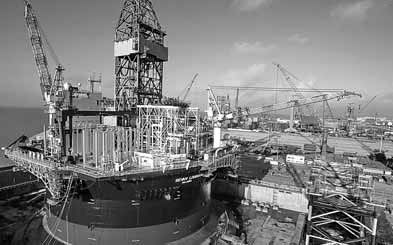Ship industry recovers on a rising tide of innovation
|
Thanks to its location at the Yangtze River's mouth to the Yellow Sea, Nantong has attracted shipyards from around the world. Provided to China Daily |
Located on the north of Yangtze River's mouth to the Yellow Sea, Nantong city, Jiangsu province, saw hundreds of shipyards prosper along its riverbank and seacoast in the past century. But then the tide changed.
Big shipbuilders from Singapore and Japan set up their branches in Nantong from the late 1990s, and helped upgrade the techniques and management of the Chinese shipyards, including the state-owned China Ocean Shipping (Group) Company (COSCO), which established its shipyards in Nantong and Qidong, a county in Nantong, after 2000.
Yet, after the 2008 global financial crisis, shipbuilding became burdened by overcapacity, because of the decline in overseas demand. Shipbuilding's share of Nantong's economy fell from nearly 30 percent 10 years ago to about 19 percent now.
Many medium-scale and small shipyards, mostly privately-owned, changed their core business to crude steel processing but this sector also suffered from overcapacity.
But their have been success stories.
The large players, such as Cosco Nantong Shipyard and Cosco Offshore (Qidong) Yard, transformed their main business from shipbuilding to ship repair and the construction of offshore units in 2009.
In the past five years, the two shipyards have successfully built and delivered a series of offshore engineering units for clients from Norway, the United States, the United Kingdom, Australia, Holland, Denmark, Brazil, Mexico and Malaysia.
The two factories' annual production value rose from zero in 2008 to more than 6 billion yuan ($972 million) last year.
The output of the whole shipbuilding industry in Nantong was valued at about 1,200 billion yuan last year. Over 90 percent of the ships are exported.
The transformation from a shipbuilder to an offshore unit producer is not an easy process, because the latter raises higher technological requirements.
Some technological obstacles in the workshop are not that easy to overcome. Nearly 90 percent of facilities and equipment used on the offshore units are imported from abroad, "even air conditioners", which account for almost 80 percent of the production costs, squeezing the profit margin to such an extent that the shipbuilders have no choice but try to boost innovation.
As a result COSCO established its offshore research and design institute in Nantong in 2011, with the ambition to turn its two factories to world-class producers.
To strengthen its R&D capacity in advanced technology in the offshore oil and gas industry, the institute cooperates with a host of key universities and large State-owned enterprises in China, and the Det Norske Veritas, a classification body in Norway, the American Bureau of Shipping and the China Classification Society.
The institute now has an R&D team of more than 800 professionals in structural, mechanical, electrical, outfitting, drilling and topside modules.
Li Jun, a spokesman of Cosco Nantong Shipyard, said: "Working with foreign partners make us grow fast.
"We upgraded our safety standards rapidly so that even a scratch on a workers' finger, if caused by the design of our products, means our products are not safe."
After accumulating enough experience about the industry and the market and with orders for a few years, they will be able to manufacture more and more equipment that is today imported, said Gu Xiang, a senior engineer and assistant for general manager in Cosco Nantong Shipyard.
"Based on our keen observation of the market, we plan to make some popular offshore units and ships even before we get the orders, to save financial costs."
Ding Congrong contributed to this story.



















